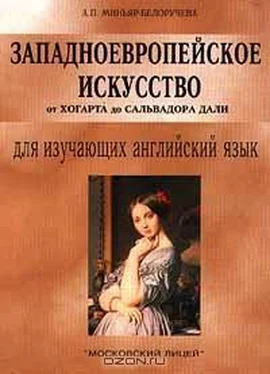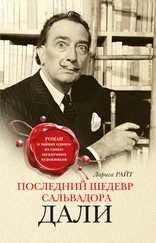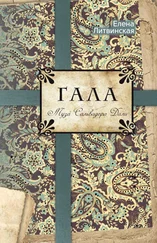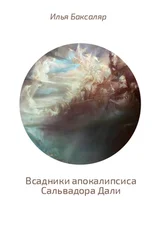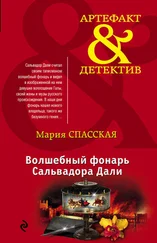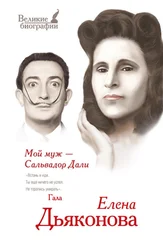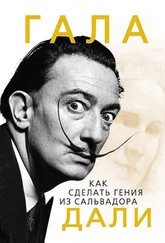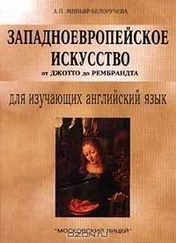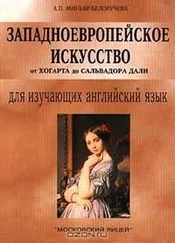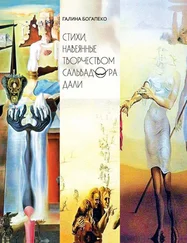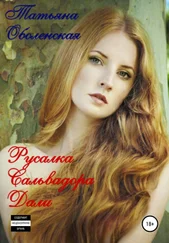Последние годы жизни Энгра были омрачены битвами сначала с романтиками во главе с Делакруа, затем с реалистами, которых возглавлял Курбе.
VI. Summarize the text.
VII. Topics for discussion.
1. The principles of Ingres's painting.
2. Ingres's style and characters.
The greatest artistic genius of the turn of the eighteenth century was a Spaniard, Francisco Jose de Goya у Lucientes. He made a trip to Italy and was not impressed either by antiquity or by the Renaissance. Goya was a lifelong rebel against artistic or intellectual straitjackets. He managed to skip the Neo-classical phase entirely and passed directly from a personal version of the Rococo to Romantic stage.
In 1786 Goya was appointed painter to the king and in 1799 he became the first court painter. After 1792 Goya was totally deaf, and it liberated him from some of the trivialities of life for meditation on its deeper significance. Goya's brilliant portraits of the royal court may have been influenced by Gainsborough. But his characterisations are far more vivid, human and satiric. Goya's supreme achievement in portraiture is the Family of Charles IV , painted in 1800, an inspired parody of Velazquez's Las Meninas . Thirteen members of the royal family, representing three generations, are assembled in a picture gallery of the palace, with Goya himself painting a large canvas in the shadows at the left. The king, with his red face and with his chest blazing with decorations, and the ugly ill-natured queen are painted as they were. Alfonce Daudet called them «the baker's family who have just won the big lottery prize». Goya's purpose is deeper than satire: he has unmasked these people as evil. Only some of the children escape his condemnation.
The Maja Desnuda is one of the most delightful paintings of the female nude in history. There exists a sketchier clothed version of the picture. The nude was formerly explained as an unconventional portrait of the duchess of Alba, a patron and a close friend of Goya's.
The frivolity of this picture contrasts with Goya's denunciation of the inhumanity of warfare, of which the most monumental example is The Third of May, 1808, at Madrid: The Shooting on Principe Pio Mountain , depicting the execution of Madrid rebels by Napoleonic soldiery. The painting commissioned by the liberal government after the expulsion of the French in 1814 and 'done in the same year, is the earliest explicit example of «social protest» in art. Previously the warfare had been generally depicted as glorious, cruelties – as inevitable. Goya treats the firing squad as a many-legged, faceless monster, before whose level, bayoneted guns are pushed groups of helpless victims, the first already shattered by bullets and streaming with blood, the next gesticulating wildly in the last seconds of life, the third hiding the horror from their eyes with their hands. A paper lantern gives the only light; in the dimness the nearest houses and the church tower of the city almost blend with the earth against the night sky. Through the medium of broad brushstrokes, Goya communicates unbearable emotion with thick pigment, achieving at once a timeless universality and an immediacy of the reality of the event.
Goya's passionate humanity speaks uncensored through his engravings. Goya made several series of etching-aquatints, the earliest of which Los Caprichos (The Caprices) , of 1796-98, is widely imaginative. The first section, dealing satirically with events from daily life, is surpassed by the second, devoted to fantastic events enacted by monsters, witches, and malevolent nocturnal beasts from the demonic tradition of Spanish folklore.
The introductory print of the second section shows the artist asleep at his table loaded with idle drawing instruments, before which is propped a tablet inscribed «El sueno de la razon produce monstruos»(«the sleep of reason produces monsters»). Reason, the goddess of the 18-th century philosophers, once put to sleep, allows monsters to arise from the inner darkness of mind. Goya's menacing cat and the rising clouds of owls and bats glowing in light and dark are lineal descendants of the beasts of medieval art.
Instead of merely threatening human life, as in Los Caprichos , the monsters take over entirely in Goya's final series, Los Disparates (The Follies) , engraved between 1813 and 1819. The ultimate horror of Goya's imagination seethes through the series of dark frescoes the artist painted with fierce strokes on the walls of his own house from 1820 to 1822, depicting a universe dominated by unreason and terror, and making cruel mock of humanity.
One of Goya's rare references to Classical mythology illustrates the most savage of Greek legends. Saturn Devouring one of his Sons is an allegory of Time which engulfs us all. The glaring, mindless deity holds with colossal hands the body of his helpless son, from which he has torn and is chewing the head and the right arm – all indicated with brushstrokes of an unimagined ferocity.
Now nearing eighty, the great painter was not to live long with these creatures of his despairing imagination. After the restoration of a reactionary monarchic government in 1823, he left for France and died in exile.
Make sure you know how to pronounce the following words:
Francisco Goya; duchess; Alba; Daudet; Saturn; parody; bayonet; malevolent; nocturnal; demonic; caprices; lineal
Notes
Family of Charles IV – «Групповой портрет семьи короля Карла IV»
Maja Desnuda – «Маха обнаженная»
The Third of May, 1808, at Madrid: The Shooting on Principe Pio Mountain – «Расстрел испанских повстанцев французами в ночь на 3 мая 1808 г.»
Los Caprichos (The Caprices) – «Каприччос»
Los Disparates (The Follies) – «Диспаратес»
Saturn Devouring one of his Sons – «Сатурн, пожирающий одного из своих сыновей»
Tasks
I. Read the text. Make sure you understand it. Mark the following statements true or false.
1. Goya's portraits of the royal court were influenced by Van Dyck.
2. The Family of Charles IV , painted in 1799, is an inspired parody of Velazquez's Las Meninas.
3. In 1786 Goya made several series of etching-aquatints.
4. In 1815 after the expulsion of the French from Spain the liberal government commissioned Goya a painting.
5. When Reason sleeps monsters arise from the inner darkness of mind.
6. The monarchy was restored in Spain in 1828.
II. How well have you read? Can you answer the following questions?
1. Was Goya a lifelong rebel against artistic and intellectual straitjackets? What artistic trend did Goya represent?
2. What is Goya's supreme achievement in portraiture? How many figures are portrayed in this portrait? How are the king and the queen depicted? How was this portrait characterised by Alfonce Daudet? What did Goya want to express by this portrait?
3. What is one of the most delightful paintings of the female nude in history? Is there any other version of this picture? How was the nude explained?
4. In what painting did Goya denounce the inhumanity of war? What does this work of art represent? How is the firing squad treated? How are the victims depicted?
5. What is represented in The Caprices ? What is pictured in the first section? What does the introductory print of the second section show? What did Goya paint on the walls of his own house?
Читать дальше
